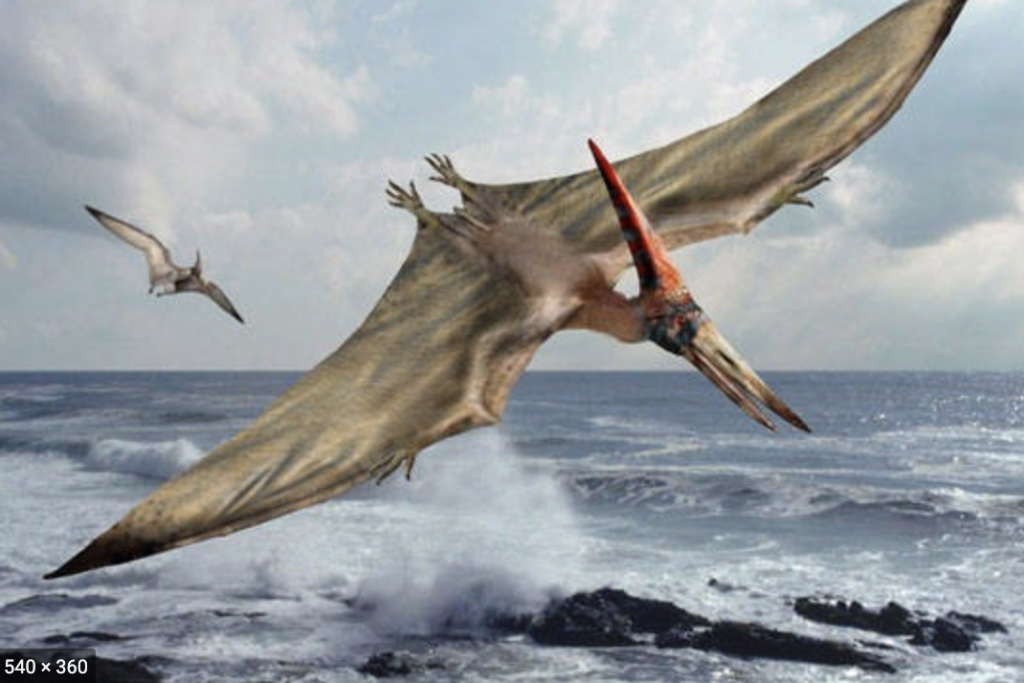
Pterodactyl Bar B Que
By Zaslow Crane
Begin by adding 10-20 onions (chopped, medium), to a big pot. Saute’ them in cheap sherry until they’re translucent. Next you’ll need about a gallon of quality catsup and a gallon of molasses (but you might not want to use all of the latter), sweetness in Bar be Que is a personal taste, and a too-sweet bird can be the cause of a mountain of leftovers (and there’s only so much three day old pteradactyl hash one can eat!).
Next, you need around a dozen heads of garlic, minced finely and 10-30 jalapenos minced. Though, again, you’ll want to keep your guests’ sensibilities in mind in deciding exactly how many peppers to use. As you will with the Chipotle. I recommend about a half cup to three cups depending on how big of capsicum fans they are.
I’m reminded of a time a couple of years ago, when I had relatives visiting from Wisconsin. One morning when they saw me preparing scrambled eggs, and noticed me chopping half an onion to sauté into the eggs, remarked: “Boy, you sure like your food spicy, don’tcha?”
You have no idea…No idea at all…
Besides one can always shake a little ground up Thai chili powder on at the last minute.
So, be judicious when deciding upon the amount of garlic, onions and especially peppers you’re going to stir into your sauce. Think of your…audience.
Next you’ll want things to make the sauce especially savory. Think: Salt, pepper, paprika. I love sweet Hungarian paprika. Also Celery powder (to taste) and just a hint of mustard. And my secret ingredient: Asian chili oil.
Simmer all this together for at least an hour on low heat stirring frequently before even thinking of starting “the bird” roasting.
Meanwhile, you can prepare the bird by plucking as many of the feathers as you can get off easily…but don’t worry, the rest of the smaller feathers usually burn up in the cooking process. You can take the bird outside and get the kids involved. The littler they are the more they seem to enjoy plucking the bird. Plus, they’re “helping”.
The bird should be dressed and prepared as you would any game bird if you hunt and kill it yourself; first, hanging it upside down by its talons and draining the blood from a generous slit in its neck.
Then you’ll want to gut it and cut the head off, rinsing the inside of the carcass thoroughly. These critters will eat almost anything and you want your dinner well cleaned.
Just a side note: If you’re able, save the blood- as much as possible. Mix it with soil when you’re transplanting new plants and watch the new shoots rocket out and up in a few weeks!
You could pick up a bird at your local butcher shop, but where’s the fun in that? It must be said that while you can go to the local meat market and procure a young (and presumably tender) Pterodactyl any time you wish, it is a given that finding, trapping and dispatching it yourself will result in a fresher tasting and full bodied sensory experience. The young Pterodactyl flesh seems to suck up the roasted garlic of the sauce, rendering it sweet and savory. I don’t know how or why, I just know this to be true, so my advice is to endeavor to capture your own.
“And how”, I hear you asking, “Might this be done? How might an ambitious first time Pterodactyl bar be que-er procure his first bird?”
Well, it is a well know fact that these birds have a weakness for sweet and savory.
Those in -the -know lay out entire loaves of bread cut length-wise and slathered with peanut butter and jelly.
A side note: The birds seem to respond best to Welch’s Grape jelly and Jif (crunchy) peanut butter.
Once they’ve settled on the ground and are absorbed in devouring the treat you’ve left out for them, throw a bag over their head and beat them about the head with a baseball bat taking care not to damage other portions of the bird (I’ve found “aluminum” bats usually work best).
Once the bird is drained, you’ll probably want to cut off the wings. There’s really no meat there to speak of, and they slow the cooking of the carcass. So sever the wings at the “shoulder” and set them aside for later. They make wonderful shelters for recent transplants if the temperature outside dips near freezing.
Occasionally a “bird” will be 60 pounds or more. This is a prodigious bird, fit for serving a small community. Ordinarily a pterodactyl will be closer to twenty or thirty pounds and are as easily roasted as an adolescent dimetrodon (though considerably less work! – That huge heat sink on their backs is a bear to cut off with anything less that a chain saw, and that’s so messy). This is why, I believe, pterodactyl are a far more popular BBQ choice, despite the somewhat “bigger” flavor of the “dimey”.
However it’s important to keep in mind that ordinary land animals and land dinos will cook at different speeds from birds or pterasaurs given the fact that land animals have solid bones that transmit heat better and birds have hollow bones that actually hinder a quick cooking process.
It is for that reason that I personally recommend cooking over a medium heat slowly turning the bird on a spit and basting it liberally with your fresh bar be que sauce, which will eventually caramelize over the carcass from the extended heat, making the bird as tender and flavorful as …well…chicken. So if this is your first (and if it is, I’m very happy for you!) allow lots of time, don’t rush and start early.
The drumsticks are a perennial favorite and, around our house a constant point of contention: many of my relatives, when arriving at one of our cookouts, brag that they can eat an entire drumstick all by themselves. I’ve heard of this happening, but personally, I’ve never once seen it.
While popular with dark meat fans, it is in my experience, that one drumstick is invariably a meal for three or four. So slice it liberally against the grain of the meat, and add a dollop of bar be que sauce atop each serving for smiling faces all around, finish with sides of beans, steamed corn on the cob (in season), lightly steamed greens, oven fried potatoes and deep fried, breaded okra, with a sour cream and onion dipping sauce.
I always try to arrange the “bird” on a special platter with two sturdy handles, and which we keep for just such occasions. I position in such a way as to display the bounty and beauty of a huge roasted bird and – also to facilitate the efficient carving of said fowl.
When freshly roasted, it is 160-165 (minimum interior temp) but being poultry- sort of- it loses it’s heat quite rapidly, so efficient serving and plating of the entrée’ is of paramount importance. Plan ahead, “stage” the plates and silverware at the ready. Don’t allow pushy relatives to dissuade you from your plan. Stick with it and you’ll find yourself a successful host again and again.
Allow 4-5 hours; Serves 30… or so…


OMG – a Pteradactyl – a little warm and spicy, but I can smell it already.